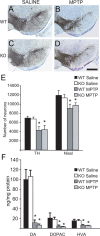Unexpected lack of hypersensitivity in LRRK2 knock-out mice to MPTP (1-methyl-4-phenyl-1,2,3,6-tetrahydropyridine)
- PMID: 20016100
- PMCID: PMC2846613
- DOI: 10.1523/JNEUROSCI.4357-09.2009
Unexpected lack of hypersensitivity in LRRK2 knock-out mice to MPTP (1-methyl-4-phenyl-1,2,3,6-tetrahydropyridine)
Abstract
Mutations in the leucine-rich repeat kinase 2 (LRRK2) gene are the most common known cause of Parkinson's disease (PD). Whether loss of LRRK2 function accounts for neurodegeneration of dopamine neurons in PD is not known, nor is it known whether LRRK2 kinase activity modulates the susceptibility of dopamine (DA) neurons to the selective dopaminergic toxin, 1-methyl-4-phenyl-1,2,3,6-tetrahydropyridine (MPTP). To better understand the role of LRRK2 in DA neuronal survival and its role in the susceptibility of DA neurons to MPTP, we generated LRRK2 knock-out (KO) mice lacking the kinase domain of LRRK2. Here, we show that LRRK2 KO mice are viable and have no major abnormalities and live to adulthood. The dopaminergic system is normal in LRRK2 KO mice as assessed via HPLC for DA and its metabolites and via stereologic assessment of DA neuron number in young and aged mice. Importantly, there is no significant difference in the susceptibility of LRRK2 KO and wild-type mice to MPTP. These results suggest that LRRK2 plays little if any role in the development and survival of DA neurons under physiologic conditions. Thus, PD due to LRRK2 mutations are likely not due to a loss of function. Moreover, LRRK2 is not required for the susceptibility of DA neurons to MPTP.
Figures



Similar articles
-
Long Non-coding RNA HOTAIR Promotes Parkinson's Disease Induced by MPTP Through up-regulating the Expression of LRRK2.Curr Neurovasc Res. 2016;13(2):115-20. doi: 10.2174/1567202613666160316155228. Curr Neurovasc Res. 2016. PMID: 26979073
-
Connexin 30 deficiency attenuates A2 astrocyte responses and induces severe neurodegeneration in a 1-methyl-4-phenyl-1,2,3,6-tetrahydropyridine hydrochloride Parkinson's disease animal model.J Neuroinflammation. 2018 Aug 13;15(1):227. doi: 10.1186/s12974-018-1251-0. J Neuroinflammation. 2018. PMID: 30103794 Free PMC article.
-
Selective expression of Parkinson's disease-related Leucine-rich repeat kinase 2 G2019S missense mutation in midbrain dopaminergic neurons impairs dopamine release and dopaminergic gene expression.Hum Mol Genet. 2015 Sep 15;24(18):5299-312. doi: 10.1093/hmg/ddv249. Epub 2015 Jun 29. Hum Mol Genet. 2015. PMID: 26123485 Free PMC article.
-
The impact of reactive oxygen species and genetic mitochondrial mutations in Parkinson's disease.Gene. 2013 Dec 10;532(1):18-23. doi: 10.1016/j.gene.2013.07.085. Epub 2013 Aug 15. Gene. 2013. PMID: 23954870 Review.
-
Genetic analysis of Parkinson's disease-linked leucine-rich repeat kinase 2.Biochem Soc Trans. 2012 Oct;40(5):1042-6. doi: 10.1042/BST20120112. Biochem Soc Trans. 2012. PMID: 22988862 Free PMC article. Review.
Cited by
-
Parkinson's disease: leucine-rich repeat kinase 2 and autophagy, intimate enemies.Parkinsons Dis. 2012;2012:151039. doi: 10.1155/2012/151039. Epub 2012 Aug 30. Parkinsons Dis. 2012. PMID: 22970411 Free PMC article.
-
Leucine-rich repeat kinase 2 for beginners: six key questions.Cold Spring Harb Perspect Med. 2012 Mar;2(3):a009407. doi: 10.1101/cshperspect.a009407. Cold Spring Harb Perspect Med. 2012. PMID: 22393539 Free PMC article. Review.
-
Toxin-induced and genetic animal models of Parkinson's disease.Parkinsons Dis. 2010 Dec 22;2011:951709. doi: 10.4061/2011/951709. Parkinsons Dis. 2010. PMID: 21234368 Free PMC article.
-
Mitochondrial dysfunction in Parkinson's disease: pathogenesis and neuroprotection.Parkinsons Dis. 2010 Dec 26;2011:617472. doi: 10.4061/2011/617472. Parkinsons Dis. 2010. PMID: 21234411 Free PMC article.
-
Regulation of LRRK2 expression points to a functional role in human monocyte maturation.PLoS One. 2011;6(6):e21519. doi: 10.1371/journal.pone.0021519. Epub 2011 Jun 27. PLoS One. 2011. PMID: 21738687 Free PMC article.
References
-
- Biskup S, Moore DJ, Celsi F, Higashi S, West AB, Andrabi SA, Kurkinen K, Yu SW, Savitt JM, Waldvogel HJ, Faull RL, Emson PC, Torp R, Ottersen OP, Dawson TM, Dawson VL. Localization of LRRK2 to membranous and vesicular structures in mammalian brain. Ann Neurol. 2006;60:557–569. - PubMed
-
- Dawson TM, Dawson VL. Molecular pathways of neurodegeneration in Parkinson's disease. Science. 2003;302:819–822. - PubMed
-
- Gasser T. Update on the genetics of Parkinson's disease. Mov Disord. 2007;22(Suppl 17):S343–S350. - PubMed
-
- Greggio E, Zambrano I, Kaganovich A, Beilina A, Taymans JM, Daniëls V, Lewis P, Jain S, Ding J, Syed A, Thomas KJ, Baekelandt V, Cookson MR. The Parkinson disease-associated leucine-rich repeat kinase 2 (LRRK2) is a dimer that undergoes intramolecular autophosphorylation. J Biol Chem. 2008;283:16906–16914. - PMC - PubMed
Publication types
MeSH terms
Substances
Grants and funding
LinkOut - more resources
Full Text Sources
Other Literature Sources
Molecular Biology Databases
Research Materials
